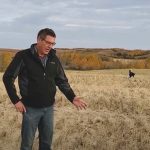Are we going somewhere in a handbasket?
I thought the government was looking after us but maybe I had the wrong country

What’s the relationship between soil organic matter and crop insurance?
Adjusting insurance premiums based on soil quality factors is an idea now being discussed

Sask. farmer’s soil health approach results in ‘soil armour’
Farmer Tim Nerbas protects his soil with a layer of organic material he calls “soil armour.” He says that and other conservation farming practices to improve soil health on his farm may take time — but it’s worth the wait

Grainews keeps long-retired reader up to date
A magazine rack fashioned out of western red cedar helps connect this one-time Manitoba farm boy to his roots

Small sprayers great for range and pasture…
A more compact machine is an ideal fit for smaller fields

Can biological crop inputs for cereals and oilseeds work?
Foliar-applied nitrogen-fixing biologicals for grains and oilseeds are a great concept. Here, four Prairie farmers share their experiences

Canada’s Farm Show live for 2022
All of the popular features and much more will be welcoming visitors in June

The best fit for pre- or post-harvest treatments
With erratic growing season conditions producers need to be flexible with fall weed control plans

Olds College takes a hands-on look at new technology
Park the tractor. Learning how to seed the field and spray crops with an unmanned drill and field sprayer is just another day in the life of students in 2022

No easy fix for pulse crop problems
A Saskatchewan pulse producer weighs his options and risks for planting lentils in fields previously hit hard by aphanomyces — plus, the latest research and recommendations on root rot management in pulses


